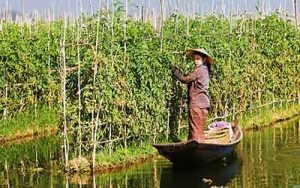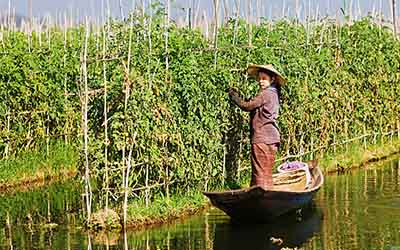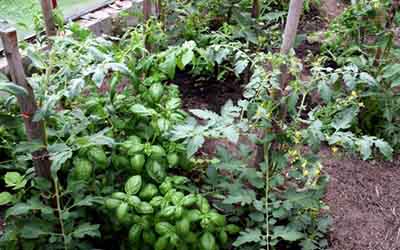The Aztec civilization, flourishing from the 14th to the 16th century in the Valley of Mexico, stands as a testament to human ingenuity and adaptability.
Among these innovations, the floating gardens, or “Chinampas,” represent a remarkable blend of engineering, environmental science, and agricultural productivity that enabled the Aztecs to sustain a dense population in the challenging environment of the Mexican highlands.
The chinampas were essentially man-made islands created on the shallow lake beds in the Valley of Mexico, particularly around the area that is now known as Xochimilco.
These floating gardens were constructed by staking out the shallow lake bed and then fencing in the area with wattle.
The enclosed space was then filled with mud, lake sediment, and decaying vegetation, creating fertile plots of land that were remarkably productive.
This ingenious method allowed the Aztecs to cultivate crops such as maize, beans, squash, amaranth, tomatoes, chilies, and flowers year-round, significantly enhancing their food supply and supporting their expanding empire.
Nestled in the heart of the Valley of Mexico, amidst the expansive lakes and marshes, the Aztecs faced the challenge of feeding a burgeoning population on a terrain that was less than conducive to traditional farming methods.
It was this challenge that gave birth to the chinampas, an ingenious solution that turned the aquatic landscape into one of the most productive agricultural systems of the pre-Columbian Americas.
Historical Background
The origin of chinampas can be traced back to the early 14th century, during the Aztecs’ rise to power in Central Mexico.
As the Aztecs settled in the marshy regions of Lake Texcoco, they encountered a landscape that was rich in biodiversity but poor in dry land suitable for cultivation.
In response, they engineered chinampas by staking out rectangular areas in the shallow lake beds, enclosing them with wattle fences, and filling them with mud, decaying vegetation, and other organic materials dredged from the lake’s bottom.
This created fertile islands that rose above the lake’s surface, enabling the cultivation of maize, beans, squash, amaranth, and a variety of flowers and medicinal plants.
Technical Description
Chinampas were typically about 30 meters (98 feet) long and 2.5 meters (8.2 feet) wide, although sizes varied.
These artificial islands were anchored to the lakebed with willow trees planted at the corners, which provided stability and helped prevent erosion.
The trees’ roots grew underwater, intertwining with the structure of the chinampas and reinforcing the soil.
Canals were dug around these islands, providing a means to easily transport goods by canoe and ensuring that the crops received ample water.
The result was a highly efficient, self-sustaining agricultural system that could yield multiple harvests annually.
Detailed Explanation of Construction Process
The construction of chinampas began with the delineation of the area on the shallow lake bed using sticks.
These areas were then enclosed with fences made from woven reeds and sticks, creating a barrier to keep the soil in place.
The enclosed area was subsequently filled with layers of mud, aquatic weeds, and decomposing plant matter dredged from the bottom of the lake.
Over time, these materials compacted and formed a rich, fertile soil capable of supporting various crops.
One of the key features of this system was its reliance on the natural cycles and resources of the lakes.
The decomposition of plant matter not only enriched the soil but also created a heat that helped to accelerate the growth of crops.
This made chinampas incredibly productive, with the ability to support up to seven harvests a year for certain crops.
Role of Canals and Transportation
The chinampas were separated by a network of canals, which served multiple purposes.
Firstly, they allowed for efficient irrigation of the crops, as water could be easily channeled to the roots.
Secondly, these canals provided a means of transportation, enabling the Aztecs to move goods and people quickly through the watery landscape of their capital, Tenochtitlán.
Canoes were used to access each chinampa, facilitating the movement of produce to local markets and contributing to the economic vitality of the Aztec empire.
Cultural Significance of the Floating Gardens Aztec
The chinampas were more than an agricultural innovation; they were a cornerstone of Aztec society, deeply intertwined with its economy, religion, and daily life.
These floating gardens not only fed the populous capital of Tenochtitlán but also reflected the Aztecs’ cosmological views and their relationship with the natural world.
The chinampas provided the nutritional foundation for the Aztec empire, enabling the cultivation of a variety of crops essential for sustenance and economic prosperity.
Maize, beans, squash, chilies, and flowers thrived in the fertile soils of the chinampas, supporting a dense population and fueling the growth of Tenochtitlán into one of the largest cities of its time.
The surplus produce from the chinampas was a vital component of the Aztec economy, facilitating trade within the empire and with neighboring regions.
This agricultural abundance allowed for the development of a complex society with a rich cultural life, underpinned by a strong economy.
Connection to Aztec Religious Practices
The chinampas also held spiritual significance for the Aztecs. They believed that the balance between the earth, water, and the cosmos was reflected in the microcosm of the chinampas, where the elements coalesced to create life.
Many of the crops grown on the chinampas were used in religious ceremonies and offerings to the gods, with maize being particularly sacred.
The Aztecs viewed agriculture as a divine duty, a means of sustaining the gods who, in turn, sustained the world.
The cyclical nature of chinampa farming, with its continuous regeneration and fertility, symbolized the cycles of life, death, and rebirth that were central to Aztec cosmology.
Current State of the Floating Gardens in Xochimilco
Xochimilco’s chinampas continue to be used for agricultural production, maintaining the traditional methods passed down through generations.
Farmers still grow flowers, vegetables, and medicinal plants, much like their Aztec ancestors. However, the urban expansion of Mexico City and the resulting environmental pressures have put this ancient system at risk.
Pollution, water depletion, and land subsidence threaten the delicate ecological balance necessary for the chinampas to thrive.
Efforts to Preserve and Restore the Chinampas
In response to these challenges, a range of initiatives has been launched by governmental and non-governmental organizations, aiming to preserve and restore the chinampas.
These efforts include cleaning the canals, reintroducing native plants and animals to improve biodiversity, and implementing sustainable farming practices.
Educational programs aimed at local farmers and the wider community seek to raise awareness about the importance of the chinampas and the need to protect them for future generations.
Economic and Social Challenges
The chinampas are not only agricultural lands but also the livelihoods of local communities. However, the economic viability of traditional chinampa agriculture is under threat from several fronts.
The global market favors large-scale, industrial agriculture, making it difficult for small-scale chinampa farmers to compete.
Moreover, the younger generation is increasingly moving away from agriculture towards urban employment, leading to a loss of traditional knowledge and practices.
Social challenges also emerge from the tension between preserving the chinampas as historical and ecological sites and the push for modernization and urban expansion.
Land speculation and unauthorized development threaten the integrity of the chinampas, as agricultural land is converted for residential or commercial use.
The Balance Between Tourism, Preservation, and Functionality
Tourism presents both an opportunity and a challenge for the chinampas. On one hand, it brings much-needed attention and economic support to the area, highlighting the cultural and historical importance of the chinampas.
On the other hand, unregulated tourism can lead to environmental degradation and disrupt traditional agricultural activities.
Finding a balance between promoting tourism, preserving the environmental and cultural heritage of the chinampas, and maintaining their functionality as productive agricultural lands is a complex challenge.

Conclusion on the floating gardens Aztecs
The floating gardens of the Aztecs, known as chinampas, are a remarkable testament to human ingenuity, sustainability, and the profound relationship between cultures and their environments.
These ancient floating gardens highlight the Aztecs’ advanced understanding of agricultural engineering, ecology, and water management, offering lessons that remain relevant in today’s world, especially as we face environmental challenges and seek sustainable solutions.
Reflecting on the historical, cultural, and environmental significance of the chinampas, it becomes clear that these ancient practices embody principles of sustainability that are increasingly important to life.
The chinampas system demonstrates the potential of traditional ecological knowledge to inform modern sustainable agriculture, urban planning, and community development.
By integrating natural cycles and biodiversity into agricultural practices, the Aztecs managed to create a highly productive and resilient system that supported their civilization’s growth and prosperity.
In the modern era, the remaining chinampas in Xochimilco serve as a living museum, a source of agricultural biodiversity, and a model for sustainable practices.
Recommendations
How to become a farmer with no experience



